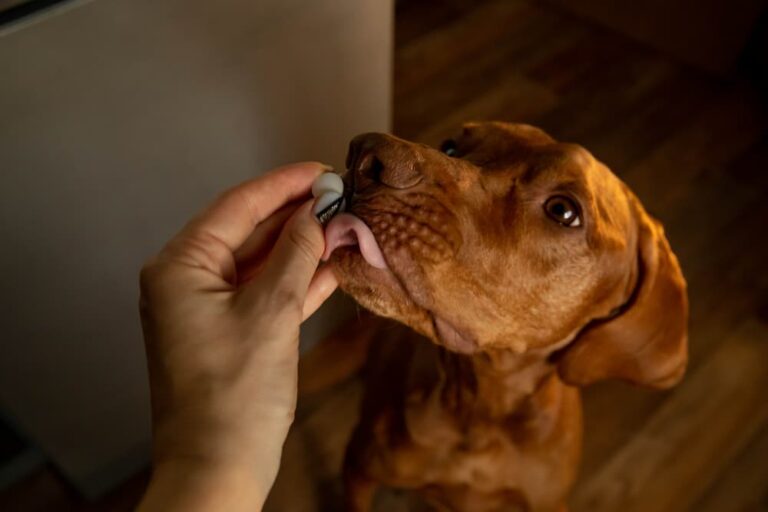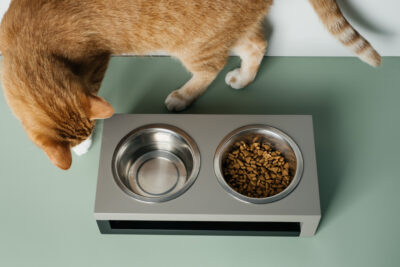Fluoxetine for Dogs

Medication details
- Medication type: Selective serotonin reuptake inhibitor
- Form: Chewable tablets, oral solution, compounded tablets, capsules, compounded capsules
- Prescription required? Yes
- FDA approved? Yes
- Brand names: Reconcile®
- Common names: Fluoxetine
- Available dosages: Chewable tablets: 8mg, 16mg, 32mg, 64mg: Oral solution: 4mg/mL, 10mg/mL, 12mg/mL, 15mg/mL, 16mg/mL, 20mg/mL, 30mg/mL, 50mg/mL: Compounded tablets: 2.5mg, 5mg; Capsules: 10mg, 20mg, 40mg; Compounded capsule: 5mg, 6mg, 7mg, 7.5mg, 12mg, 13mg, 14mg, 24mg, 25mg, 26mg, 50mg
- Expiration range: Varies, refer to package instructions for specific details
If you find your dog is pacing, panting, and hiding frequently, they may be experiencing anxiety or fear. Similar to people, pets can feel anxious for a variety of reasons, such as abrupt changes in the home or separation from their pet parent.
Surprisingly, a recent study found that over 99 percent of dogs had some type of behavioral issue, including anxiety or fear (1). Many dogs benefit from anxiety medications, such as fluoxetine, to address these concerns and improve their quality of life.
What Is Fluoxetine?
Fluoxetine for dogs is an antidepressant, specifically a selective serotonin reuptake inhibitor (SSRI). It has been FDA-approved since 2007 and is available for dogs under the brand name Reconcile®. Some veterinarians may prescribe the human variation called Prozac®, but this is considered “off-label” meaning it is not FDA-approved for this use. However, this is not uncommon in the veterinary industry.
Fluoxetine is only available through a prescription from a veterinarian, and it is widely available at small animal practices throughout the United States.
What Does Fluoxetine Look Like?
Fluoxetine comes in tablets, oral solution, and capsules. The tablets are brown and circular. The oral solution is oil-based and can be flavored in a variety of options, such as chicken or beef. The capsules can be a variety of colors depending on the manufacturer.
What Is Fluoxetine Used For in Dogs?
Dogs on fluoxetine have a behavioral issue, most commonly separation anxiety. The medication is prescribed to reduce anxiety in dogs and the corresponding behaviors associated with it, such as barking or chewing.
Fluoxetine can also be prescribed to treat aggression and compulsive disorders. Dogs experiencing compulsions, such as frequently chasing their tails or licking their fur, can benefit from this medication.
How Does Fluoxetine Work?
As mentioned, fluoxetine is a selective serotonin reuptake inhibitor. This means it increases the level of serotonin in the dog’s brain by preventing its reabsorption in the body. Serotonin has many important functions, such as regulation of mood, sleep, and stress levels. When these levels increase, a dog gets a burst of “feel-good” hormones that decrease anxiety and compulsive behaviors.
How to Give Fluoxetine to Dogs

Fluoxetine is given by mouth once daily. Reconcile® for dogs is given to dogs to chew and swallow and is generally readily accepted since it is beef-flavored. Pet parents can disguise the capsules in a pill pocket for easier administration. The oral solution can be flavored by a compounding pharmacy so dogs can either lick it directly from their bowl or receive the dose in a syringe.
Fluoxetine Side Effects in Dogs
Any time a pet parent gives a medication, it is important to watch for side effects. While most dogs tolerate this medication well, there are a few serious side effects that may occur, especially if dosing is done incorrectly.
Fluoxetine side effects in dogs may include the following:
- Lethargy
- Decreased appetite
- Weight loss
- Vomiting
- Diarrhea
- Panting
- Restlessness
- Incoordination
- Increased drooling
- Trembling
- Seizures
- Increased aggression
There are side effects for stopping fluoxetine in dogs, which can include increased anxiety and aggression. When discontinuing fluoxetine, it is important to taper it over time to reduce unwanted withdrawal symptoms. Your veterinarian can advise you on the best approach to safely do this.
Reactions With Other Drugs and Medications
Fluoxetine should only be given as prescribed by a veterinarian. Be sure to mention any other medications your dog is taking to the veterinarian so that appropriate precautions can be taken to prevent drug interactions.
Fluoxetine should not be given alongside several other medications, which include the following:
- Monoamine oxidase inhibitors, such as selegiline
- Opioids, such as tramadol
- Selective serotonin reuptake inhibitors, such as sertraline
- Tricyclic antidepressants, such as amitriptyline
- Phenothiazines, such as acepromazine
- Benzodiazepines, such as diazepam
- Anti-seizure medications, such as phenytoin
- Non-steroidal anti-inflammatories, such as aspirin
- Anti-anxiety medications, such as buspirone
- Appetite stimulants, such as cyproheptadine
- St John’s wort
Fluoxetine for Dogs Dosage
The dosage for fluoxetine varies based on the dog’s weight. It is generally combined with other behavioral modification programs, such as separation anxiety training. Fluoxetine is administered once daily by mouth. It can be given with or without food. It is approved for use in dogs who are at least 6 months of age and older.
Fluoxetine Cost
The costs of fluoxetine can vary greatly based on where the veterinary practice is located as well as what formulation is prescribed. Compounded medications are more expensive than the tablets because they require special preparation by a pharmacy. In general, fluoxetine ranges from $15-$60 a month depending on the dog’s size.
Fluoxetine Storage Instructions
Fluoxetine should be stored safely out of reach of pets and children. It should be kept in a light-resistant container. It does not need to be refrigerated.
Reference
- Beaver, Bonnie. (2024). The Prevalence of Behavior Problems in Dogs in the United States. Journal of Veterinary Behavior. 76. 10.1016/j.jveb.2024.11.001.









